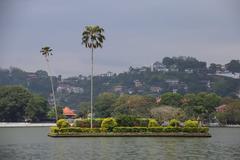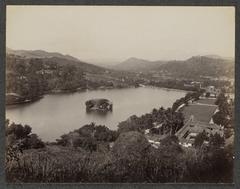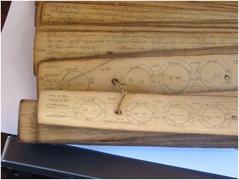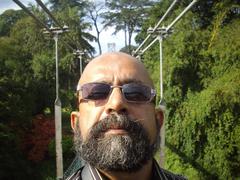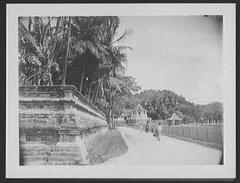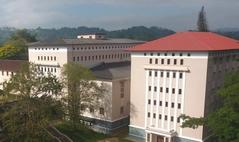
Kandy Lake Visiting Hours, Tickets, and Historical Sites Guide
Date: 14/06/2025
Introduction to Kandy Lake and Its Cultural Significance
Kandy Lake—locally known as Kiri Muhuda, or the “Sea of Milk”—is a renowned landmark set in the heart of Kandy, Sri Lanka. Established in 1807 by King Sri Wickrama Rajasinghe, the last ruler of the Kingdom of Kandy, the lake was designed both to beautify the royal palace complex and symbolize the spiritual and political stature of the Kandyan monarchy. Its close proximity to the Temple of the Sacred Tooth Relic (Sri Dalada Maligawa), a UNESCO World Heritage Site, further enhances its importance, placing it at the spiritual epicenter of the city. The lake’s tranquil presence provides a peaceful oasis amid urban bustle and remains an essential part of Kandy’s cultural landscape (Wonders of Ceylon; Laure Wanders).
Table of Contents
- Introduction
- Historical Origins and Royal Vision
- Construction and Architectural Features
- Colonial Transformations
- Symbolism and Cultural Importance
- Visiting Kandy Lake: Practical Information
- Preservation and Modern-Day Features
- Notable Facts and Figures
- Frequently Asked Questions (FAQ)
- Visual Content Suggestions
- Conclusion
Historical Origins and Royal Vision
Commissioned in 1807 by King Sri Wickrama Rajasinghe, Kandy Lake was a visionary addition to the royal palace complex, intended to serve both as a scenic centerpiece and a symbol of the connection between the monarchy and Buddhism. It was constructed by converting paddy fields into a reservoir, strategically placed beside the Temple of the Sacred Tooth Relic (Wonders of Ceylon; Wikipedia). The lake’s creation marked the last major urban development under the Kandyan kings.
Construction and Architectural Features
Walakulu Wall (Cloud Wall)
The Walakulu Wall, or “Cloud Wall,” is a distinctive parapet running along the lake’s southern and eastern banks. Designed with a unique cloud motif, it exemplifies the artistic vision of King Sri Wickrama Rajasinghe. This wall, though incomplete due to the British occupation, remains an enduring architectural feature (Destinationless Travel).
Central Island
At the lake’s center is a small, palm-studded island, originally a royal pleasure garden. During the British colonial period, it was repurposed as an ammunition store (BestOfLanka). The island is not open to the public, but its picturesque silhouette enhances the lake’s scenery.
Walking Path and Viewing Points
A paved walking path of approximately 3.2 to 3.4 kilometers circles the lake, inviting visitors for leisurely strolls, jogging, and photography. Benches and shaded areas provide comfortable rest spots. The Kandy Viewpoint and selected lakeside pavilions offer panoramic vistas ideal for sunrise and sunset photography (The Common Wanderer).
Colonial Transformations
Following the British conquest of Kandy in 1815, the lake was slightly reduced in size and adapted for colonial purposes. The British imposed restrictions to protect the lake’s ecology—a policy that continues to this day, with fishing and swimming prohibited (Wonders of Ceylon; Wikipedia).
Symbolism and Cultural Importance
Kandy Lake is imbued with spiritual significance in Buddhist tradition, symbolizing mental clarity and purity. Its waters serve as a symbolic moat, protecting the sacred Temple of the Tooth. The lake is central to the city’s cultural life, especially during the annual Esala Perahera festival, when processions of dancers, drummers, and decorated elephants trace its shores to honor the sacred relic (BestOfLanka; Wonders of Ceylon).
Visiting Kandy Lake: Practical Information
Visiting Hours and Tickets
- Lake Access: Open 24 hours; no entry fee.
- Temple of the Sacred Tooth Relic: Open daily 5:30 AM – 8:00 PM; ticket required (approx. LKR 1,500 for foreigners; LKR 500 for locals) (Explore Vacations).
Accessibility
- The lakeside path is mostly flat and paved, suitable for wheelchairs and strollers, although some sections may be uneven. Benches and shaded pavilions offer rest areas for all visitors.
Travel Tips and Nearby Attractions
- Best Times: Early mornings and late afternoons for cool weather and better lighting.
- Nearby Sites: Temple of the Sacred Tooth Relic, Royal Palace of Kandy, Udawattakele Forest Reserve, Queen’s Hotel, and Kandy Garrison Cemetery.
- Dining: Numerous cafés and restaurants along the lake, including colonial-era Queen’s Hotel café.
- Getting There: Kandy Lake is centrally located, approximately 800m from Kandy city center and 1.4km from the railway station (TripXL).
- Accommodation: Ranges from luxury hotels to guesthouses within walking distance (MakeMyTrip; That Goan Girl).
Special Events and Guided Tours
- The annual Esala Perahera (July/August) transforms the lake’s surroundings with vibrant processions (Overa Tours).
- Guided tours are widely available and recommended for deeper historical and cultural context.
Preservation and Modern-Day Features
Kandy Lake remains under heritage protection. Its ecosystem supports local wildlife, including herons, kingfishers, bats, and monitor lizards (The Common Wanderer). Community rituals, such as feeding fish, and cultural performances continue to reinforce its importance in local life.
Notable Facts and Figures
- Year of Construction: 1807
- Founder: King Sri Wickrama Rajasinghe
- Area: About 6.5 hectares (16 acres)
- Shoreline: Around 3.2–3.4 km
- Key Features: Walakulu Wall, central island, underground tunnels
- Protected Status: No fishing or swimming allowed (Wikipedia)
Frequently Asked Questions (FAQ)
Q: What are Kandy Lake’s visiting hours?
A: The lake and walking paths are accessible 24/7. Adjacent attractions like the Temple of the Sacred Tooth Relic open from 5:30 AM to 8:00 PM.
Q: Is there an entry fee for Kandy Lake?
A: No, the lake is free to visit. Tickets are required for nearby sites.
Q: Are guided tours available?
A: Yes, local guides can enrich your visit with historical and cultural insights.
Q: Is Kandy Lake wheelchair accessible?
A: The path is mostly accessible, but some areas may require assistance.
Q: Can I visit during the Esala Perahera festival?
A: Yes, but expect large crowds and book accommodations early.
Visual Content Suggestions
- Panoramic images of the lake and the Walakulu Wall
- Photos of the central island and Temple of the Sacred Tooth Relic
- Esala Perahera festival processions
- Interactive maps and virtual tour videos
Conclusion
Kandy Lake stands as a living testament to Sri Lanka’s royal past, spiritual devotion, and natural beauty. Its tranquil waters, scenic paths, and central location make it a must-visit for anyone exploring Kandy. With free, round-the-clock access, proximity to major attractions, and a wealth of historical and cultural experiences, Kandy Lake promises an enriching and memorable visit. Plan ahead for festivals, respect local customs, and consider guided tours to get the most from your trip.
Plan Your Visit
References and External Links
- Wonders of Ceylon
- Laure Wanders
- Overa Tours
- Thrillophilia
- TripXL
- Damith Danthanarayana
- Destinationless Travel
- BestOfLanka
- That Goan Girl
- Tourist Places Guide
- MakeMyTrip
- The Common Wanderer
- Wikipedia
- Sunshine Seeker
- Roaming Voyager
